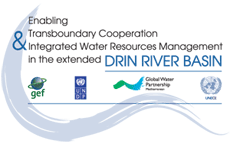Aquifers
The region has significant and important groundwater resources. Preliminary identification or delineation of aquifers and/or groundwater bodies have been performed by the Riparians’ responsible institutes. This has led to the identification of 84 aquifers and/or groundwater bodies.
Using this information, an aggregation exercise was attempted through the Transboundary Diagnostic Analysis (TDA) -developed through the GEF Drin Project- to homogenize the aquifers identified in each of the Riparians by following purely geological and hydrogeological criteria as a first attempt in preparing a map of the Drin Basin’s aquifers (see Figure below). Karst aquifers with high permeability cover the largest part of the Drin Basin (around 34 percent, especially in the north-western part; see Table below), while the area with no significant aquifers (nearly impermeable) is almost 28 percent of the total (central and eastern parts of the basin). There are also karst aquifers with moderate permeability (9 percent of the basin) and porous aquifers of moderate to good permeability (23 percent in total). Overall, almost two thirds of the Drin Basin has hydrogeological characteristics that allow potential groundwater exploitation, while more than 50 percent is of high permeability and therefore has increased vulnerability.
Table: Aquifer types in the Drin Basin and their area
| Description | Area (m2) | % of total |
| No significant aquifers, nearly impermeable | 5,548,986,524 | 27.89 |
| Fissured aquifer, low permeability | 1,328,316,263 | 6.68 |
| Intergranular porous aquifer, good permeability | 2,816,882,506 | 14.16 |
| Intergranular porous aquifer, moderate permeability | 1,739,484,494 | 8.74 |
| Karst aquifer, moderate permeability | 1,752,224,459 | 8.81 |
| Karst aquifer, high permeability | 6,708,365,668 | 33.72 |
Figure: Map of types of aquifers in the Drin Basin
Due to the complex hydrogeological structures, the surface hydrological boundaries often do not coincide with the hydrogeological boundaries of the catchments of surface-water bodies. For example, Lake Prespa has an underground hydraulic connection with Lake Ohrid. The catchment area of the Radika River is affected by the areas of Resen, Ohrid and Struga, Piskupstina and Debar, as well as the mountain areas of Galičica, Stogovo, Ilinska Planina and Karaorman, among others.
Nine potential transboundary aquifers were identified through the TDA. The largest identified transboundary aquifer is shared by Albania, Kosovo1 and North Macedonia, comprising intergranular formations of low permeability. The next largest transboundary aquifer, and also the most important, is shared by Albania, Kosovo and Montenegro, and comprises karst formations of high permeability, with an extent of approximately 2,000 km2.
The main uses of groundwater in the Drin Basin are potable water supply and irrigation, often through non-registered abstractions. Many agglomerations are not connected to the regional water supply systems and have their own local water supply systems using groundwater sources.
Table: Potential transboundary aquifers in the Drin Basin
| Aquifer no. | Description | Area (m2) | % of total |
| 1 | Karst-fissure, high permeability | 2,062,404,100 | 22.81 |
| 2 | Fissure | 1,414,883,610 | 15.65 |
| 3 | Karst-fissure, variable permeability | 1,214,111,975 | 13.43 |
| 4 | Karst-fissure | 612,633,819 | 6.78 |
| 5 | Intergranular | 623,087,480 | 6.89 |
| 6 | Karst-fissure, high permeability | 388,992,452 | 4.30 |
| 7 | Intergranular, low permeability | 2,180,953,418 | 24.13 |
| 8 | Intergranular | 324,837,138 | 3.59 |
| 9 | Karst-fissure | 217,884,172 | 2.41 |
Map: Potential transboundary aquifers in the Drin Basin
[1] This designation is without prejudice to positions on status, and is in line with UNSCR 1244/1999 and the ICJ Opinion on the Kosovo declaration of independence.






